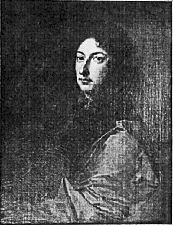Anthony Ashley Cooper, 1st Earl of Shaftesbury facts for kids
Quick facts for kids
The Earl of Shaftesbury
|
|
|---|---|
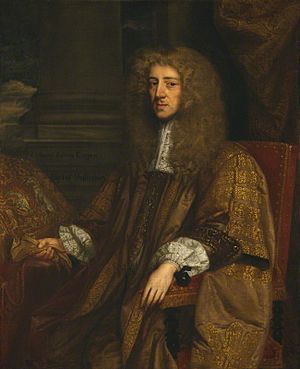
Portrait by John Greenhill
|
|
| Lord President of the Council | |
| In office 21 April 1679 – 15 October 1679 |
|
| Lord Lieutenant of Dorset | |
| In office 1672–1674 |
|
| President of the Board of Trade | |
| In office 16 September 1672 – 1676 |
|
| Lord Chancellor | |
| In office 1672–1673 |
|
| Chancellor of the Exchequer | |
| In office 13 May 1661 – 22 November 1672 |
|
| Governor of the Isle of Wight | |
| In office 1660–1661 |
|
| English Council of State | |
| In office July 1653 – December 1654 |
|
| Member of Parliament for Wiltshire |
|
| In office April 1653 – December 1660 |
|
| High Sheriff of Wiltshire | |
| In office 1647–1648 |
|
| Personal details | |
| Born |
Anthony Ashley Cooper
22 July 1621 Wimborne St Giles, Dorset |
| Died | 21 January 1683 (aged 61) Amsterdam, Dutch Republic |
| Spouses | Margaret Coventry (1639–1649, her death) Frances Cecil (1650–1654, her death) Margaret Spencer (1655–1683, his death) |
| Children | Anthony Ashley-Cooper, 2nd Earl of Shaftesbury (1652–1699) |
| Alma mater | Exeter College, Oxford |
| Military service | |
| Rank | Colonel |
| Battles/wars |
|
Anthony Ashley Cooper, 1st Earl of Shaftesbury (born July 22, 1621 – died January 21, 1683) was an important English politician. He held high positions under both the Commonwealth of England (a time when England was a republic) and King Charles II.
He was a key figure in the Exclusion Crisis. This was a big debate about whether Charles II's Catholic brother, James, should be allowed to become king. Shaftesbury led the group that wanted to stop James. This group later became known as the Whig party.
Shaftesbury also supported the famous thinker John Locke. Together, they helped write rules for the Fundamental Constitutions of Carolina in 1669.
During the Wars of the Three Kingdoms, Shaftesbury first supported the King's side (the Royalists). But in 1644, he switched to support Parliament. He worked for the government during the Commonwealth. However, he disagreed with Oliver Cromwell when Cromwell tried to rule without Parliament.
Shaftesbury helped bring King Charles II back to the throne in 1660. Charles II then made him a lord, known as Lord Ashley. Later, he became the Earl of Shaftesbury in 1672. He was part of a group of five top ministers called the Cabal Ministry.
When it became known that Charles's brother James was secretly Catholic, Shaftesbury worried. Many English Protestants believed a Catholic king would threaten Parliament's power. Shaftesbury's efforts to block James from the throne led to a big political fight. He was even arrested for treason but was later cleared. Fearing for his life, he moved to Amsterdam in 1682, where he died.
Contents
- Biography
- Early Life and First Marriage (1621–1640)
- Early Political Career (1640–1660)
- Statesman under the Commonwealth and Protectorate (1652–1660)
- Restoration Politician (1660–1683)
- Legacy
- See Also
Biography
Early Life and First Marriage (1621–1640)
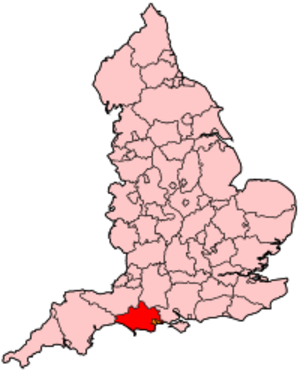
Anthony Ashley Cooper was born on July 22, 1621, in Wimborne St Giles, Dorset. His mother was Anne Ashley, and his father was Sir John Cooper. Anthony was named after his mother's father, Sir Anthony Ashley.
Sir Anthony Ashley was an important person. He had worked for Queen Elizabeth I. In 1622, he married a young woman named Philippa Sheldon. She was related to George Villiers, 1st Duke of Buckingham, a very powerful man in the King's court.
Anthony's father became a baronet in 1622. This meant he was given a special title by the King. His father was also a Member of Parliament. He supported those who were against certain religious ideas at the time. Anthony's first teacher, Aaron Guerdon, had Puritan beliefs.
Anthony's mother died in 1628. His father remarried a wealthy woman named Mary Moryson. Through her, Anthony gained a connection to the future Arthur Capell, 1st Earl of Essex. Anthony's father died in 1630, making him a rich orphan. He inherited his father's title and became Sir Anthony Ashley Cooper.
Because his father had debts, Anthony's inheritance was managed by the Court of Wards and Liveries. This court ordered some of his father's lands to be sold to pay off the debts. Anthony felt this court was unfair and corrupt.
He lived with his father's friends, Sir Daniel Norton and later Edward Tooker. Both of his tutors had Puritan leanings.
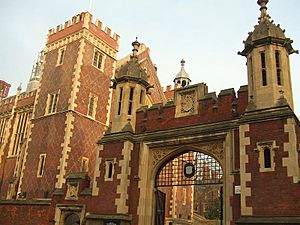
At age 15, in 1637, Anthony went to Exeter College, Oxford. He studied under a Calvinist professor. He left Oxford without finishing his degree. In 1638, he joined Lincoln's Inn, a place where he could study law. Here, he heard many Puritan sermons.
In 1639, at 19, Anthony married Margaret Coventry. Her father, Thomas Coventry, 1st Baron Coventry, was a top official for King Charles I. Since Anthony was still young, they lived in his father-in-law's homes in London.
Early Political Career (1640–1660)
Parliament (1640–1642)
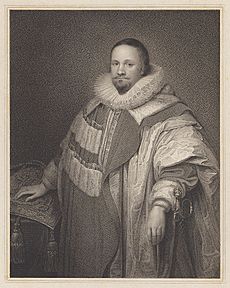
In March 1640, Anthony was elected as a Member of Parliament for Tewkesbury. This happened thanks to his father-in-law, Lord Coventry.
Later in 1640, he tried to get elected for Downton. But Denzil Holles, a leader against the King, blocked him. People worried that Anthony, being related to the King's Lord Keeper, would be too loyal to the King.
Royalist (1642–1644)
When the English Civil War began in 1642, Anthony first supported King Charles I. In 1643, he even raised his own soldiers for the King. He helped negotiate the surrender of Dorchester. He agreed that the town would not be harmed.
However, Prince Maurice's troops plundered Dorchester anyway. This made Anthony very angry. He was supposed to become governor of Weymouth and Portland. But Prince Maurice blocked this, saying Anthony was too young. Anthony appealed to Edward Hyde, who arranged a compromise. Anthony became governor but agreed to step down later for more important roles.
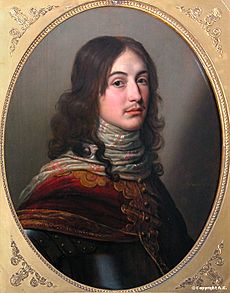
Parliamentarian and Second Marriage (1644–1652)
In early 1644, Anthony left all his posts under the King. He went to the Parliamentarian headquarters. He explained that he believed King Charles I was being influenced by Catholics. He felt the King was not protecting the Protestant religion or the people's freedoms. So, he joined the Parliamentarian side.
He fought with Parliament's forces in Dorset. In 1645, he resigned his military roles to focus on his political career. He also invested in a plantation in Barbados in 1646.
Not much is known about his activities in the late 1640s. He likely opposed the execution of King Charles I. However, he worked with the new government. He became a justice of the peace and High Sheriff of Wiltshire. In 1650, he swore loyalty to the new government.
His first wife, Margaret, died in 1649. They had no children. In 1650, he married Lady Frances Cecil. They had two children, one of whom, Anthony, lived to adulthood. Frances died in 1652, at only 19 years old.
Statesman under the Commonwealth and Protectorate (1652–1660)
In 1652, Anthony was appointed to a committee working on law reform. In 1653, he received a full pardon for his time as a Royalist. This allowed him to return to public office.
Oliver Cromwell chose Anthony to serve in the Barebone's Parliament. Anthony was also named to the English Council of State. He worked to continue law reforms. He sided with the moderate members of Parliament. He voted against getting rid of tithes (church taxes). He also voted to dissolve Barebone's Parliament.
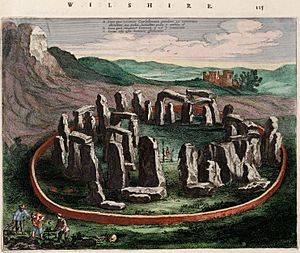
When England got a new constitution, Anthony was again named to the Council of State. In 1654, he won an election to be a Member of Parliament for Wiltshire. He also won for Tewkesbury and Poole, but chose to represent Wiltshire.
Anthony generally supported Cromwell at first. But he became worried that Cromwell was relying too much on the army instead of Parliament. This led to a break between them. In 1655, Anthony stopped attending the Council. He introduced a resolution to make it illegal to collect taxes not approved by Parliament. Cromwell then dissolved Parliament.
King Charles II, who was in exile, heard about Anthony's break with Cromwell. He wrote to Anthony, offering a pardon if he would help bring back the monarchy. Anthony did not reply.
In 1655, Anthony married his third wife, Margaret Spencer.
Anthony was elected to Parliament again in 1656. But Cromwell's Council of State prevented him and many others from taking their seats. Anthony protested this. He eventually took his seat in 1658. He spoke out against Cromwell's new "Other House" (a kind of new House of Lords). He wanted the old House of Lords to be restored.

In 1659, Anthony was elected to Parliament again. He sided with those who wanted to limit the power of Richard Cromwell (Oliver Cromwell's son and successor). He also continued to argue for restoring the old House of Lords.
When Richard Cromwell dissolved Parliament, Anthony tried to get his seat back for Downton. He was also re-appointed to the Council of State. Many people thought he secretly supported the King. He was even arrested for being involved in a royalist uprising, but he was found innocent.
In 1659, the army dissolved Parliament again. Anthony and other Council members continued to meet secretly. They saw Sir George Monck, a commander in Scotland, as their best hope. They urged Monck to restore Parliament. Anthony was involved in plots to start pro-Parliament uprisings.

In December 1659, the army decided to support Parliament again. Parliament reassembled, and Anthony was elected to the Council of State. In January 1660, he was finally allowed to take his seat as a Member of Parliament for Downton.
When General Monck marched into London, Anthony urged him to restore the members of the old Parliament. Monck agreed. The restored Parliament then elected Anthony to the Council of State. In March 1660, Parliament voted to dissolve itself.
In spring 1660, Anthony began to support bringing back the King. He was re-elected as a Member of Parliament for Wiltshire. He voted to bring back the monarchy without conditions. In May, he was one of twelve members chosen to invite Charles II to return to England.
Restoration Politician (1660–1683)
Anthony returned to England with King Charles II in late May. Charles appointed him to his Privy Council in May 1660. Anthony was officially pardoned for his support of the Commonwealth. He helped reorganize the Privy Council's committee on trade.
Anthony became a spokesperson for the government in Parliament. He argued for leniency for those who had sided with Parliament during the Civil War. He believed only those directly involved in executing Charles I should be punished. This view was accepted. He then helped sentence some of his former colleagues to death.
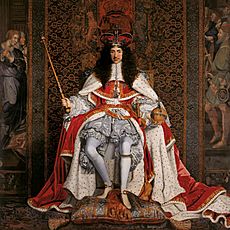
In April 1661, Charles II made Anthony a lord, calling him Baron Ashley.
Chancellor of the Exchequer (1661–1672)
Lord Ashley took his seat in the House of Lords in May 1661. The King appointed him as his Chancellor of the Exchequer. This meant he was in charge of the country's money.
In 1661–1662, Ashley opposed Charles's marriage to Catherine of Braganza. He worried it would make England too close to France. This started a long rivalry with Charles's top minister, the Earl of Clarendon.
Ashley supported being moderate towards Protestant dissenters (those who didn't follow the Church of England). He tried to make laws less harsh for them. He urged Charles to allow some freedom for peaceful Protestants and loyal Catholics. Charles issued a "Declaration of Indulgence" in 1662, but Parliament made him withdraw it.
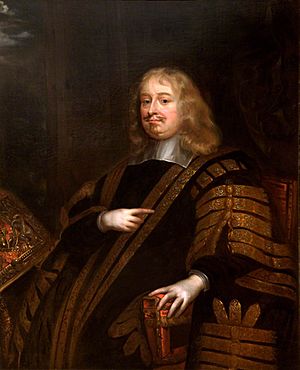
In May 1663, Ashley became one of eight "Lords Proprietors" of a large area in North America. This land became the Province of Carolina. Ashley and his assistant, John Locke, wrote a plan for the colony. This plan included the Fundamental Constitutions of Carolina.
By 1664, Ashley was part of a group that opposed Lord Clarendon. He also tried to make the penalties in the Conventicle Act 1664 less severe.
Ashley became more favored by the King in 1664 and 1665. The King even visited him at his home.
The Second Anglo–Dutch War began in 1665. Ashley opposed restricting how the King could use money voted for the war. He believed ministers should have flexibility.
In 1666–1667, Ashley supported a bill to prevent Irish cattle from being imported into England. He also criticized the King's representative in Ireland. This was one of the first times Ashley publicly disagreed with the King's court.
In October 1666, Ashley met John Locke, who became his personal secretary. Ashley was very impressed with Locke. Locke moved into Ashley's home in London in 1667. They worked closely on the plan for the Province of Carolina.
When the Lord High Treasurer died in 1667, Ashley was expected to take his place. But King Charles created a nine-man Treasury Commission instead. Ashley was named one of these commissioners.
The failures in the war led Charles II to dismiss the Earl of Clarendon in 1667. Ashley became a key member of the "Cabal Ministry." This group included Thomas Clifford, Arlington, Buckingham, Ashley, and Lauderdale. Even though they were called a "ministry," they didn't always work together. Ashley tried to pass bills to include moderate dissenters within the Church of England.
- Members of the Cabal Ministry
-
Thomas Clifford, 1st Baron Clifford of Chudleigh (1630–1673).
-
Henry Bennet, 1st Earl of Arlington (1618–1685).
-
George Villiers, 2nd Duke of Buckingham (1628–1687).
-
John Maitland, 1st Duke of Lauderdale (1616–1682).
In 1668, Ashley became very ill with a liver infection. John Locke recommended an operation that likely saved his life. Ashley was very grateful to Locke. During the operation, a tube was inserted with a copper tap. Later, his enemies would call him "Tapski" because of this.
In 1669, Ashley supported a plan to unite England and Scotland. But this failed because Scotland wanted equal representation in Parliament.
It became clear that Queen Catherine would not have children. This meant the King's brother, James, Duke of York, would be the next king. Ashley worried because he suspected James was Catholic. Ashley and Buckingham urged Charles to declare his illegitimate son, the Duke of Monmouth, as his rightful heir. They also suggested Charles divorce Catherine and remarry.
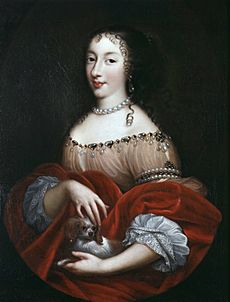
Ashley did not know about the Secret Treaty of Dover signed in 1670. In this secret treaty, Charles II agreed to become Catholic and make England Catholic in exchange for money from France. Only Arlington and Clifford knew about the Catholic parts. To trick Ashley, Buckingham, and Lauderdale, Charles arranged a fake treaty. Ashley signed this fake treaty, even though he was suspicious of France.
In 1671, Ashley argued for lower taxes on sugar imports. He said it would help sugar planters in the colonies.
In 1671, Ashley and Clifford reformed England's customs system. This caused a short-term loss of money for the crown, leading to the "Great Stop of the Exchequer." Ashley was blamed, but Clifford was the main one who pushed for it.
In 1672, with the Third Anglo–Dutch War about to start, the government worried about Protestant dissenters. To calm them, Charles II issued a "Royal Declaration of Indulgence." This suspended laws punishing non-attendance at Church of England services. Ashley strongly supported this.
England declared war on the Dutch Republic in April 1672. Charles gave out new honors. Ashley was named Earl of Shaftesbury and Baron Cooper on April 23, 1672.
Lord Chancellor (1672–1673)
On November 17, 1672, the King made Shaftesbury Lord Chancellor of England. This was a very high legal and political position. As Lord Chancellor, he spoke to Parliament in February 1673. He asked for money for the war and defended the King's actions.
However, Parliament did not welcome Shaftesbury. They attacked his actions and demanded the King withdraw the Declaration of Indulgence. Charles eventually did.
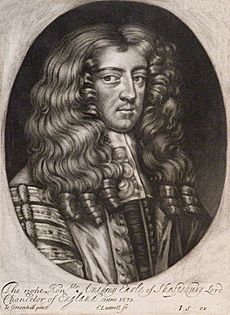
Parliament then passed the Test Act of 1673. This law required all government officials to take communion in the Church of England and reject Catholic beliefs. Shaftesbury supported this law.
After these events, it was clear the Cabal Ministry was ending. Shaftesbury began to side more with the opposition in Parliament. He wanted to end the war with the Dutch.
The Duke of York (the King's brother) did not take the Anglican sacrament. This increased Shaftesbury's worry that he was secretly Catholic. In autumn 1673, the Duke of York married a Catholic princess, Mary of Modena. This raised the possibility of a line of Catholic kings. Shaftesbury and others urged Charles II to divorce his wife and remarry a Protestant.
The Duke of York began to complain about Shaftesbury to the King. Charles II decided to remove Shaftesbury from his post. On November 9, 1673, Shaftesbury was relieved of his duties as Lord Chancellor.
Opposition to Catholicism and Break with Charles II (1673–1674)
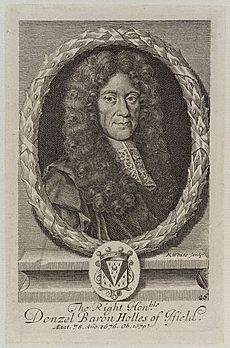
After losing the King's favor, Shaftesbury refused a bribe to support the French side at court. He said he could never support something that would harm England's religion and trade. Instead, he allied with those who wanted peace with the Netherlands. He continued to urge the King to divorce and remarry.
In January 1674, Shaftesbury led the effort to keep England free from Catholic influence. He worked with other lords who worried about a Catholic king. He gave a speech warning that Catholics in London might rebel. This led to an order expelling all Catholics from within 10 miles of London.
He also proposed a measure that would require all lords, including the Duke of York, to swear an oath rejecting the Pope. Another bill was introduced to ensure any children of the Duke of York would be raised as Protestants. Shaftesbury strongly supported this. The King was angry and stopped Parliament from meeting to protect his brother.
Shaftesbury's actions further angered Charles II. In May 1674, Shaftesbury was removed from the Privy Council and ordered to leave London.
Leader of Opposition to Danby (1674–1678)
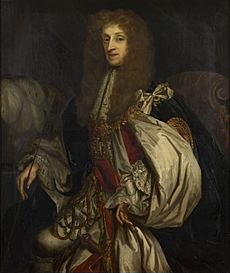
Charles II then turned to Thomas Osborne, Earl of Danby. Danby favored strict laws against both Catholics and Protestant Nonconformists.
In 1675, Shaftesbury wrote a letter arguing that the King should call new parliamentary elections. He believed frequent elections were good for both the King and the people. This letter was widely shared.
The Duke of York, who opposed Danby's harsh laws against Catholics, made a truce with Shaftesbury. They united against Danby. Danby then proposed a "Test Oath" that would make people promise not to resist the King's power or change the government. Shaftesbury led the opposition to this bill. He argued that sometimes it was necessary to resist the King's ministers.
Shaftesbury's arguments were not enough to stop the bill. The King stopped Parliament from passing it. The Duke of York thanked Shaftesbury, and Shaftesbury was allowed to meet the King. But Danby was angry, and the King again ordered Shaftesbury to leave court.
In 1675, Shaftesbury supported a candidate for Parliament who was known for supporting dissenters. This made him an enemy of other powerful lords.
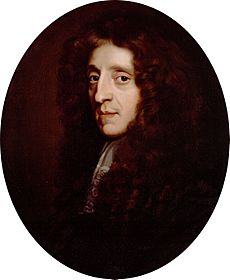
In 1675, Shaftesbury wrote a long pamphlet called A Letter from a Person of Quality to his Friend in the Country. His secretary, John Locke, likely helped him write it. The letter said that certain groups were trying to make the government an "absolute monarchy," where the King had total power. It argued that Danby's Test Oath was part of this plan. The letter also described the debates in the House of Lords. It was published anonymously and became very popular. It was one of the first books to tell the public about what happened in the House of Lords.
Shaftesbury repeated these accusations in the House of Lords. He argued that Danby and the bishops were trying to weaken the House of Lords. He said they wanted the King to rule through an army, not through the nobility. He also argued that if their ideas were followed, England's laws and freedoms would be meaningless. Shaftesbury worried about the King ruling with a standing army, like Louis XIV of France.
In November 1675, Shaftesbury supported a motion asking the King to dissolve Parliament. This motion was defeated. Parliament was then stopped from meeting until February 1677.
In 1676, a speech was given arguing that Parliament was legally dissolved because it hadn't met for 15 months. Shaftesbury took advantage of this argument. He arranged for pamphlets to be published supporting this idea. One pamphlet even said Parliament could control who inherited the crown. The Duke of York was furious about this.
When Parliament finally met in February 1677, Shaftesbury and others argued that Parliament was no longer legal. Parliament rejected this and sent the four lords, including Shaftesbury, to the Tower of London for contempt. Shaftesbury tried to get released, but the court said it couldn't interfere with Parliament. The other lords were released, but Shaftesbury refused to apologize. He worried Charles II was preparing to rule without Parliament using an army. He finally apologized in February 1678.
In March 1678, Shaftesbury urged the King to declare war on France. Charles delayed. Shaftesbury then supported disbanding the army the King was raising. Charles stopped Parliament from meeting, but the army was not disbanded, which worried Shaftesbury.

In 1678, Titus Oates claimed there was a Popish Plot to kill the King and overthrow the government. It was later found that Oates had made up most of the story. But at the time, people believed him, and there was strong anti-Catholic feeling. Shaftesbury was part of committees in the House of Lords to deal with this "plot." He pushed for the Duke of York to be removed from the King's presence. He supported a new Test Act that would exclude all Catholics from Parliament.
Oates even accused the Queen of being involved. Shaftesbury supported removing the Queen from court. Shaftesbury gained a reputation as a Protestant hero. People in London celebrated him and paid for guards to protect him.
In December 1678, discussions began about removing the Earl of Danby from office. To protect Danby, Charles II stopped Parliament from meeting. In January 1679, Charles II finally dissolved Parliament after 18 years.
The Exclusion Crisis and the Birth of the Whig Party (1679–1683)
The Habeas Corpus Parliament (1679)
New elections were held in February 1679. Shaftesbury believed most of the new Members of Parliament would oppose the King's court. He wrote a pamphlet expressing concern about France's power, the Popish Plot, and the bad influence of Danby and the Duke of York. He claimed the Duke of York was trying to create a military government.
Parliament met in March 1679. Shaftesbury gave a powerful speech warning about the dangers of Catholicism and absolute government. He criticized the King's administration in Scotland and Ireland. He also strongly denounced Danby. Shaftesbury supported Parliament's efforts to remove Danby from office.
Lord President of the Council (1679)
Charles II thought Shaftesbury was angry because he had been out of favor. So, in April 1679, Charles made him Lord President of the Council. But Shaftesbury made it clear he couldn't be bought off. He repeatedly argued that the Duke of York must be stopped from becoming king. He also continued to suggest Charles should remarry a Protestant or make the Duke of Monmouth his legitimate heir.
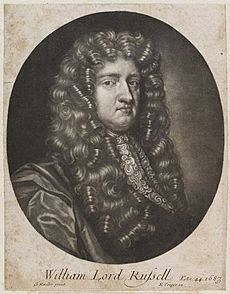
In May 1679, Shaftesbury's ally, William Russell, Lord Russell, introduced an "Exclusion Bill" in Parliament. This bill would have prevented the Duke of York from becoming king. To stop this bill, Charles II stopped Parliament from meeting and then dissolved it. The only major achievement of this Parliament was the Habeas Corpus Act of 1679, which protected people from unlawful imprisonment.
Shaftesbury kept his position on the Privy Council for a while. He and the Duke of Monmouth worked together to obstruct the King's plans. Shaftesbury even criticized Monmouth for quickly ending a rebellion in Scotland. He thought the rebellion should have continued to force Charles II to recall Parliament.
In August 1679, the King fell ill. Some feared Monmouth might try to take power. They asked the Duke of York, who was in exile, to return. Charles recovered and then sent both York and Monmouth into exile. When Charles allowed his brother to move to Scotland, Shaftesbury called an emergency meeting of the Privy Council. He did this without the King's permission. Angered by this, Charles removed Shaftesbury from the Privy Council in October 1679.
The Exclusion Bill Parliament (1679–1680)
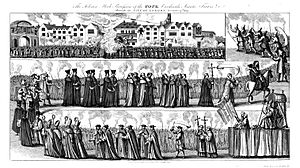
New elections were held in summer 1679. The results were not good for the King. So, Charles delayed Parliament from meeting. Shaftesbury launched a huge campaign to pressure the King to call Parliament. He urged the Duke of Monmouth to return from exile, which he did to widespread celebrations. Shaftesbury and other lords presented petitions with thousands of names, asking Charles to meet Parliament. But Charles delayed Parliament further and recalled his brother from Scotland. Shaftesbury then urged his friends on the Privy Council to resign, and some did.
In March 1680, Shaftesbury told the Privy Council he had information about an Irish Catholic rebellion. Some thought he made it up to stir up public opinion. An investigation was launched, which led to the execution of Oliver Plunkett, a Catholic Archbishop, on false charges.
In June 1680, Shaftesbury led a group that tried to charge the Duke of York with being a Catholic who broke the law. But the grand jury was dismissed before it could act. Shaftesbury tried again the next week, but the jury was dismissed again.
Parliament finally met in October 1680. Shaftesbury called for an investigation into the Popish Plot. When the Exclusion Bill came before the House of Lords again, Shaftesbury gave a passionate speech in favor of it. However, the Lords rejected the bill. Shaftesbury argued that the only alternative to excluding James was for the King to remarry. In December 1680, Shaftesbury gave another fiery speech, criticizing the Duke of York and expressing mistrust of Charles II. He urged Parliament not to approve any taxes until the King satisfied the people. Charles then stopped Parliament from meeting and dissolved it, calling for new elections in Oxford. Shaftesbury and other lords petitioned for Parliament to meet in London, but the King refused.
The Oxford Parliament (1681)
In February 1681, Shaftesbury and his supporters brought another charge against the Duke of York. The grand jury found the charge true, but legal delays stopped the prosecution.
At the Oxford Parliament, Charles said he would consider ways to address concerns about a Catholic successor, as long as it didn't change the line of succession. In March 1681, Shaftesbury suggested that the King could declare the Duke of Monmouth legitimate. Charles was furious. An Exclusion Bill was introduced, and Charles immediately dissolved Parliament.
Prosecution for High Treason (1681–1682)
The end of the Oxford Parliament marked a period where the King's supporters, the Tories, gained power. In July 1681, Shaftesbury was arrested on suspicion of high treason and sent to the Tower of London. He tried to get released, but he had to wait for his case to come before a grand jury.
The government's case against Shaftesbury was weak. Many witnesses had already lied, and the evidence was unclear. Also, the jury was chosen by the Whig Sheriff of London. So, the government had little chance of winning. In February 1682, the case against Shaftesbury was dropped. This led to big celebrations in London. People cheered for "the King, the Duke of Monmouth, and Earl of Shaftesbury."
Attempts at an Uprising (1682)
In May 1682, Charles II fell ill. Shaftesbury met with Monmouth and others to plan what to do if the King died. They decided to start a rebellion to demand a new Parliament to settle who would be king. But the King recovered, so it wasn't needed.
In July 1682, Tory candidates won the election for the Sheriffs of London. Shaftesbury worried that these Sheriffs would choose juries that would convict him if he was charged with treason again. So, Shaftesbury began discussing plans for rebellions in different parts of the country with Monmouth and others. Shaftesbury was more eager for a rebellion than the others.
After the new Tory sheriffs took office in September 1682, Shaftesbury became desperate. He continued to push for an immediate uprising.
Flight from England and Death (1682–1683)
Since his plans for an uprising failed, Shaftesbury decided to flee England. He arrived in Amsterdam in December 1682.
Shaftesbury's health got much worse during his journey. He became very ill in Amsterdam. He made his will in January 1683. He died the next day, on January 21, 1683.
His body was sent back to Dorset and buried at Wimborne St Giles. Shaftesbury's son, Lord Ashley, became the next Earl of Shaftesbury.
Legacy
In North America, the Cooper River and the Ashley River in Charleston, South Carolina, are named in his honor.
Shaftesbury has been played by actors in several TV shows and movies:
- Frederick Peisley in The First Churchills (1969)
- Martin Freeman in Charles II: The Power and The Passion
- Murray Melvin in England, My England (1995)
See Also
|


